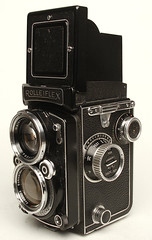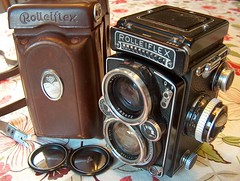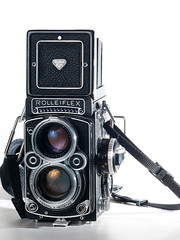Rolleiflex 2.8 series

|
| 2.8A image by Rick Oleson (Image rights) |
Germany 1949, four years after the end of WWII and the country is still in ruins. A 1944 bombing raid had destroyed the Braunschweig factory. Franke&Heidecke, who introduced their successful Rolleiflex in 1928, start a series of improvements on the well appreciated camera. The Rolleiflex 2.8A sees the light of day. In 2002 Rollei Fototechnic GmbH introduced the last version Rolleiflex 2,8 FX, later, till 2014, produced by DHW Fototechnik.
Contents
Common features
All Rolleiflex 2.8 cameras have a Compur shutter with at least B, X-sync and speeds from 1-1/500s. Only exception is the first version of the 2.8A. All models have a winding lever that stops at the first exposure. All accept at least 120 film, models from the 2.8F (#2.455.000) onwards also take 220 film.
Rolleiflex 2.8A
The Rolleiflex 2.8A model K7A of 1950 is the first one with the larger aperture Zeiss Opton Tessar taking lens and a Heidoscop viewing lens.
The first version uses a Compur Rapid X shutter with speeds of 1 - 1/400 sec., B, X-sync. But does not have M-sync. The second version released a year later in 1951 uses Compur Rapid MX shutter with speeds of 1 - 1/500 sec., B, M-X-sync. Bay II filter are used.
Rolleiflex 2.8B
The 2.8B model K7B was released in 1952 and uses a Zeiss Biometar 2,8/80mm coated lens with the finder using the Heidosmat 2,8/80mm, both use a Bayonet III filter. The shutter is the Compur Rapid MX with B, M-X-sync.
Rolleiflex 2.8C
The 2.8C model K7C was released at the end of 1952. Early versions used a Schneider Xenotar 2,8/80mm taking lens, while late versions released in 1954 use a Zeiss Planar 2,8/80mm. The shutter has changed from the previous model and now uses a Compur Rapid MXV. It supports bulb, M and X-sync. as well as a self-timer feature.
Rolleiflex 2.8D
The 2.8D model K7D of 1955 is similar to the previous model, using the same Schneider Xenotar 2,8/80mm and Zeiss Planar 2,8/80mm taking lens. The aperture and shutter exposure settings on this model now support the EV system. The EV numbers (3 to 18 EV) are on top of the shutter speed dial knob. It has an arrow indicator that can be coupled to the aperture dial. It can be uncoupled by pressing the button on top of the aperture dial. The shutter released lock guard has changed in design and is much larger.
Rolleiflex 2.8E
The 2.8E model K7E of 1956 is similar to the previous model, but the main difference it the addition of a exposure meter. The meter is based on a selenium cell. The meter is not coupled to the shutter and aperture settings. Meter settings can be adjusted on the focusing knob. A version called 2,8E2 (K7E2) became available in 1959. This version has optional metering. A version called 2,8E3 (K7E3) was made a couple of years after the K7E2.
Rolleiflex 2.8F
The 2.8F model K7F of 1960[1] was available for the longest. Available for 20 years with four minor revisions up to the K7F4 of at the end of 1981. The F versions removes the EVS system. The first revision K7F uses Planar lens and uses 120 film and has the 12 frame counter. K7F2 was released in 1965, like most 120 film camera revisions released that year it was because of 220 film and provided a new 12/24 frame counter. K7F3 is nearly the same but simplifies the back and no longer takes the flat glass adapter. The K7F4 typically has the Xenotar lens. Later limited production camera runs became available such as the Aurum and K7FP Platinum edition (1984) and the K4FPA till about 1989. In about 1988 the 2,8GX series was released.
Gallery

|
| 2.8C image by Rick Soloway (Image rights) |

|
| 2,8E image by Gerard Vogels (Image rights) |

|
| 2,8F image by Alex Luyckx (Image rights) |
Notes
- ↑ Icons of Photography Rolleiflex 2.8F: When the Rolleiflex 2.8F was created a star was born by Ivor Matanle - Amateur Photographer Magazine, 21, August 2010 pages 53-55
Bibliography
- Claus Prochnow, Rollei Report 2, third edition, Braunschweich, Lindemanns Verlag, 2008, ISBN 3-89506-220-0.